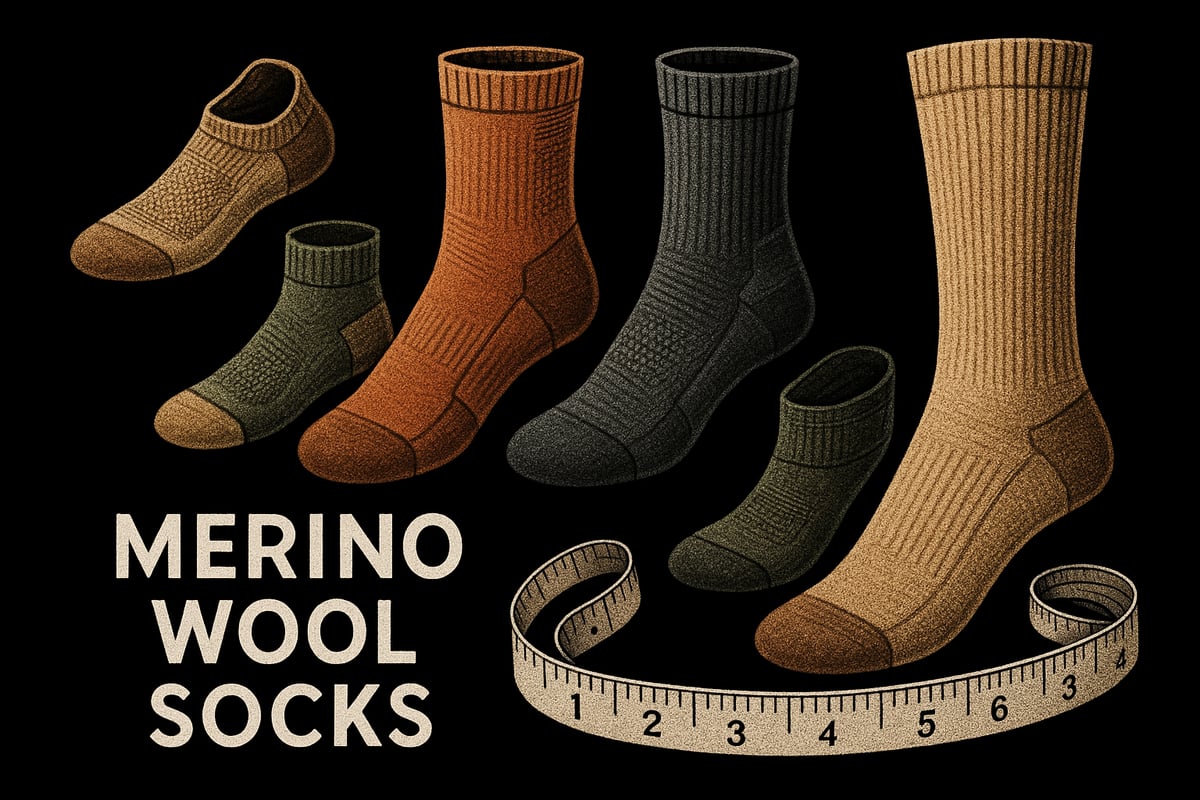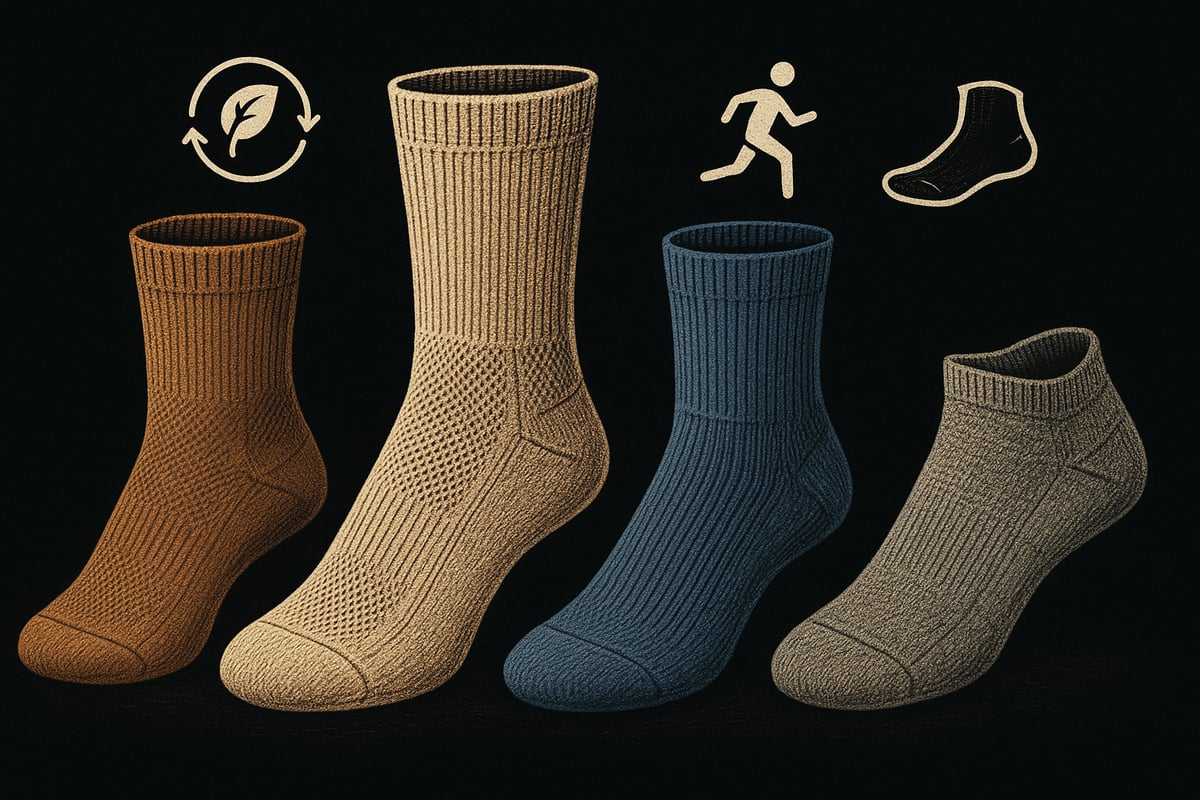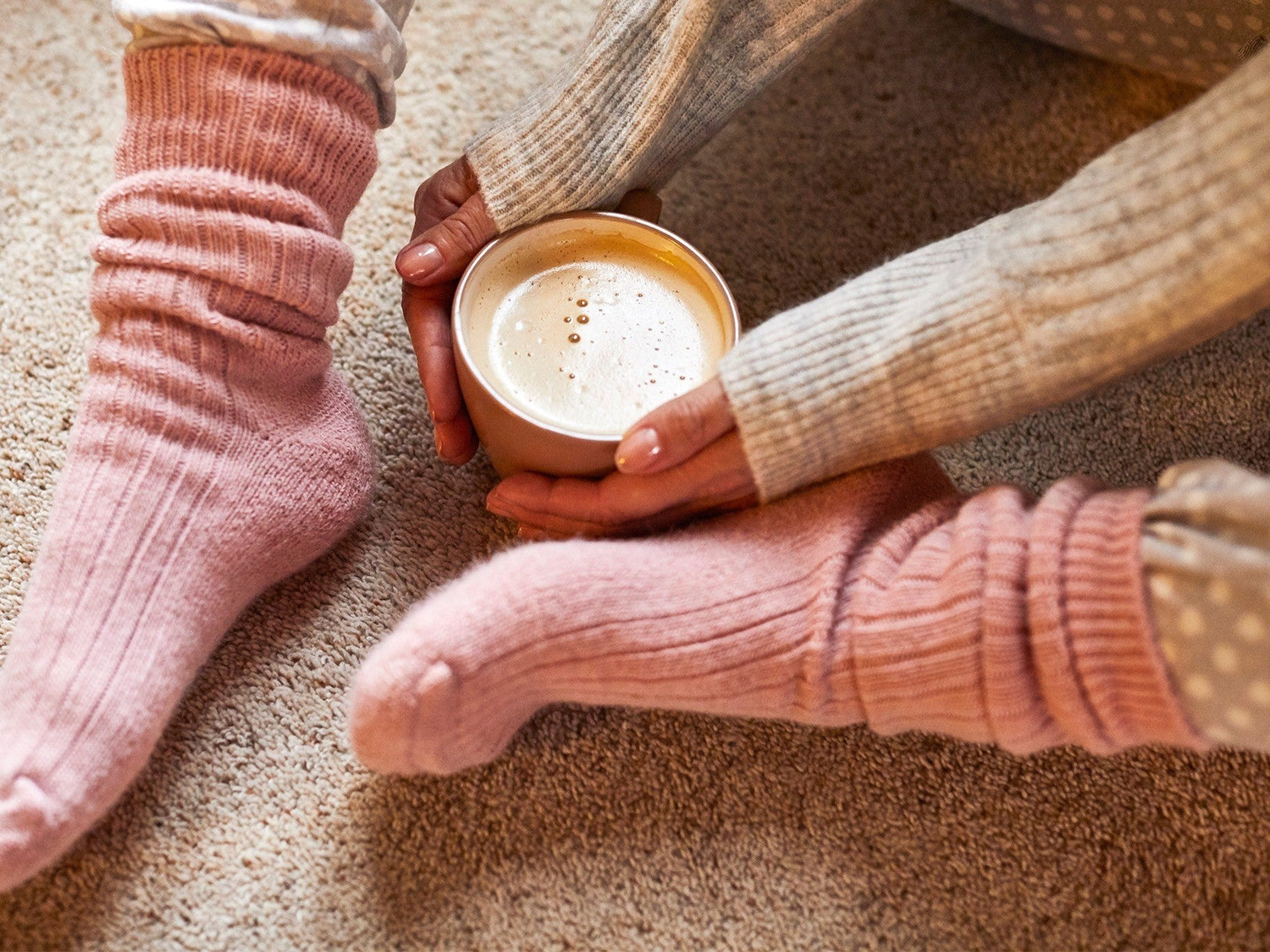
Ultimate Guide to Merino Wool Socks in 2025
Are you ready to discover why merino wool socks are the essential upgrade your feet need for 2025? Whether you crave all-day comfort at work, want to conquer new hiking trails, or simply need socks that keep your feet fresh, this guide has you covered.
We will break down what makes these socks unique and explore the science behind their unrivaled softness and performance. You'll compare top features, learn the best uses for every lifestyle, and get expert tips for buying and caring for your socks.
With the rising popularity and innovation in merino wool socks, now is the perfect time to make a smart choice for better foot health and everyday adventure. Dive in and explore everything you need to know to step confidently into the future.
What Makes Merino Wool Socks Unique?
Why are merino wool socks considered a game changer for your feet? The answer lies in the remarkable science behind the fibers, the tangible benefits over traditional materials, and the innovative features emerging in 2025. Let’s break down what truly sets these socks apart and why they’re an essential choice for comfort, performance, and sustainability.

The Science of Merino Wool
Merino wool socks are crafted from one of nature’s most advanced fibers. The secret starts with the ultra-fine diameter of merino fibers, which makes the socks incredibly soft and gentle on the skin. The natural crimp of each fiber adds elasticity, helping the socks maintain their shape and fit comfortably throughout the day.
Breathability is another standout feature. Merino fibers create tiny air pockets that regulate temperature, keeping your feet cool when it’s warm and warm when it’s cold. The fibers are also champions at drawing moisture away from the skin, ensuring your feet stay dry and comfortable. If you want to dive deeper into this, check out the latest moisture-wicking sock technology advancements.
Additionally, merino wool socks are naturally anti-bacterial and odor-resistant, making them ideal for extended wear. As a renewable and biodegradable resource, merino wool is both eco-friendly and practical. Most merino wool is sourced from sheep raised in Australia and New Zealand, regions renowned for their high-quality wool production.
Key Benefits Over Other Sock Materials
When comparing merino wool socks to cotton, polyester, and synthetic blends, the advantages become clear. Unlike cotton, which absorbs and retains moisture, merino excels at moisture management, keeping feet dry and reducing the risk of blisters. Polyester and synthetics may dry quickly, but they often lack the breathability and natural odor resistance of merino wool socks.
Here’s a quick comparison table:
| Material | Moisture Control | Odor Resistance | Warmth-to-Weight | Durability |
|---|---|---|---|---|
| Cotton | Poor | Poor | Low | Moderate |
| Polyester | Good | Fair | Moderate | High |
| Merino Wool | Excellent | Excellent | High | High |
Merino wool socks also have a better warmth-to-weight ratio than standard wool, meaning they’re lighter yet still insulating. Their hypoallergenic qualities make them suitable for sensitive skin. Hikers and athletes, in particular, favor merino for multi-day adventures, appreciating the reduced chance of chafing and the socks’ impressive longevity.
Innovations in Merino Wool Socks for 2025
The year 2025 brings exciting innovations to merino wool socks. Blended fibers, such as merino mixed with nylon or spandex, enhance performance by boosting durability and stretch. Many socks now feature seamless toe construction, eliminating pressure points and reducing friction.
Mesh ventilation zones are being integrated for superior airflow, while eco-friendly dyes and sustainable manufacturing methods are becoming the norm. New temperature-adaptive weaves help socks adjust to changing conditions, and recycled merino fibers are increasingly used to minimize waste.
Enhanced cushioning and targeted compression zones provide extra support for high-impact activities. These technical upgrades reflect a broader trend toward eco-conscious and performance-driven sock features, meeting the demands of both athletes and everyday wearers.
Environmental Impact and Sustainability
Merino wool socks are celebrated for their environmental credentials. Merino wool is a renewable resource, with sheep producing new fleece each year. The environmental footprint of merino wool socks is significantly lower than that of synthetic fibers, especially when brands use closed-loop water systems and eco-friendly production.
At the end of their life, merino wool socks are fully biodegradable, returning to the earth without leaving harmful residue. Leading brands pursue certifications like OEKO-TEX, ZQ Merino, and the Responsible Wool Standard, ensuring ethical sourcing and animal welfare. Many now promote “sheep to shelf” transparency, allowing consumers to trace their socks’ journey from farm to finished product.
Growing consumer demand for traceable and sustainable options is driving brands to adopt these practices. Merino wool socks represent a thoughtful choice for those who care about both comfort and the planet.
Types and Features of Merino Wool Socks in 2025
Choosing the right types and features for your merino wool socks can make all the difference in comfort, durability, and style. In 2025, options abound, so understanding what’s available helps you pick the perfect pair for your needs.

Sock Heights and Their Uses
Merino wool socks come in a variety of heights, each suited for specific shoes and activities. No-show and ankle socks are ideal for trainers or sneakers, keeping a low profile. Quarter and crew heights are popular for hiking boots, as they protect your ankles from rubbing and debris.
Boot socks and over-the-calf options offer extra coverage for cold weather or winter sports. In 2025, mid-crew and boot lengths are trending for their versatility. Recent data shows crew and boot heights lead among hikers, while gender-specific and unisex designs ensure a fit for everyone.
| Height | Best Use | Shoe Type |
|---|---|---|
| No-show/Ankle | Everyday, Running | Sneakers |
| Quarter/Crew | Hiking, Work | Boots, Trainers |
| Boot/OTC | Snow Sports | Ski Boots |
No matter your activity, there’s a merino wool socks height to match.
Weight and Cushioning Explained
The weight of merino wool socks impacts warmth, breathability, and comfort. Ultralight and lightweight socks are perfect for running or warm climates, while midweight, heavyweight, and extra-heavyweight provide insulation for cold weather.
Cushioning varies from no cushion for minimal bulk to full cushion for maximum comfort. Zone cushioning targets specific areas, adding support for athletic use. In 2024, midweight and full cushion styles were top sellers, reflecting a balance between comfort and performance.
- Ultralight: Running, summer
- Lightweight: Office, mild hikes
- Midweight: Hiking, daily wear
- Heavyweight: Winter, skiing
Selecting the right weight and cushioning ensures your merino wool socks meet your needs year-round.
Special Features and Technologies
Modern merino wool socks are packed with features to enhance performance. Seamless toe construction reduces friction and prevents blisters. Reinforced heels and toes add durability, while mesh panels boost breathability.
Arch support and compression zones help with fit and stability, especially for active users. Moisture management technologies, like Ultimax® and INgenius™, keep feet dry. Odor control treatments fight bacteria, making these socks ideal for multi-day adventures.
Some brands use SynchroKnit® for a custom fit, ensuring merino wool socks stay comfortable during any activity.
Merino Wool Blends and Fiber Content
Pure merino wool socks offer unmatched softness and luxury. However, blends with nylon, polyester, or spandex increase durability, stretch, and drying speed. In 2025, most performance socks feature blends, with typical ratios like 60% merino, 30% nylon, and 10% spandex.
Blended merino wool socks are favored for athletic and outdoor use, while pure merino remains popular for everyday luxury. The blend you choose affects warmth, fit, and longevity, so select based on your intended use.
- Pure merino: Luxury, casual wear
- Blends: Sports, hiking, work
The flexibility of merino wool socks blends means there’s an option for every preference.
Color, Style, and Design Trends
Style matters as much as function in 2025. Merino wool socks are available in popular colors like grey, black, blue, green, and multicolor. Patterns range from classic solids and stripes to outdoor-inspired motifs.
Earth tones and minimalist designs are especially trendy. Limited-edition collaborations, such as festival-themed or charity event socks, offer unique flair. Recent sales show grey and multicolor merino wool socks leading the market.
Customization is also on the rise, letting you express personal style while enjoying comfort.
Sizing and Fit Considerations
Getting the right fit is essential for comfort and blister prevention. Merino wool socks come in standard sizes (S, M, L, XL) and youth options. Proper sizing ensures stretch and shape retention, even after repeated wear.
Brands now offer extended sizes for better inclusivity. To avoid discomfort, consult a reliable sizing guide to match your foot shape and size. For detailed advice, check out the Sizing and fit guide for socks, which helps you select the best merino wool socks for your feet.
A perfect fit means your merino wool socks will perform and last as intended.
Best Uses for Merino Wool Socks: Everyday to Extreme
Stepping into 2025, merino wool socks have become a staple for every lifestyle. Whether you are commuting to work, training for a marathon, or embarking on an outdoor adventure, these socks deliver comfort, performance, and health benefits. Let’s explore the top ways people are wearing merino wool socks this year.

Everyday Comfort and Office Wear
Merino wool socks bring all-day freshness and comfort to your daily routine. Their breathability keeps your feet cool in meetings and during long commutes, while moisture control prevents dampness and discomfort. The natural odor resistance means you can confidently wear them from morning to evening without worry.
Stylish designs fit seamlessly with both business and casual outfits. Lightweight crew socks are especially popular for office attire, blending function with fashion. Sensitive skin benefits from the hypoallergenic properties of merino wool socks, reducing irritation.
Durability ensures they stand up to frequent washing, making them a smart investment for everyday wear. Curious about the unique advantages of natural fibre socks? Discover more about why choose our socks for daily comfort and performance.
Athletic Performance: Running, Training, and Sports
For athletes and fitness lovers, merino wool socks are a game changer. Their sweat-wicking ability keeps feet dry during intense workouts, reducing the risk of blisters. The temperature-regulating fibers maintain comfort whether you are running outdoors or lifting in the gym.
Compression and arch support features provide stability and help with muscle recovery. Many runners and gym-goers choose light or ultralight merino wool socks for minimal bulk and quick drying after exercise.
If you are training for a marathon or enjoy weekend sports, these socks offer reliable support. Athletic versions now account for a significant portion of the market, reflecting their growing popularity among active individuals.
Outdoor Adventures: Hiking, Backpacking, and Camping
Outdoor enthusiasts trust merino wool socks for hiking, backpacking, and camping. The superior insulation keeps feet warm on cold trails, while moisture management prevents sweat build-up on long hikes. Odor resistance is a major plus for multi-day treks when laundry is not an option.
Cushioning absorbs shock on rocky terrain, and reinforced zones enhance durability with heavy packs. Midweight crew socks are a favorite for hikers, balancing warmth, breathability, and comfort.
With dozens of hiking-specific models now available, merino wool socks have become essential gear for anyone hitting the trails, whether for a weekend or a thru-hike.
Specialized Uses: Skiing, Snowboarding, Hunting, and Fishing
Merino wool socks excel in extreme environments, making them the top pick for winter sports and outdoor pursuits. Over-the-calf and boot-length options provide extra warmth and protection inside ski and snowboard boots, while seamless construction prevents chafing during long sessions.
Heavyweight, full-cushion designs offer impact absorption and insulation for cold, snowy days. Hunters and anglers also benefit from moisture-wicking and odor control, keeping feet dry and comfortable in unpredictable conditions.
Color options range from camouflage for stealth to bright tones for visibility, meeting the needs of every outdoor enthusiast.
Medical and Wellness Applications
The gentle touch of merino wool socks makes them ideal for medical and wellness needs. Diabetic-friendly designs often feature non-binding tops to promote circulation, along with seamless toes to prevent irritation and sores.
Cushioned soles provide relief for joint and foot pain, making them suitable for recovery and post-surgery care. The hypoallergenic and antimicrobial properties are especially valuable for those with sensitive skin or allergies.
Demand for wellness-focused merino wool socks is rising, as more people seek comfort and health benefits in their everyday footwear.
How to Choose the Best Merino Wool Socks for Your Needs
Looking for the perfect pair of merino wool socks in 2025? With so many options and new technologies, making the right choice can feel overwhelming. Let’s break down the key steps so you can confidently find socks that match your lifestyle, values, and budget.

Assessing Your Lifestyle and Activities
Before buying merino wool socks, consider how and where you’ll wear them. Are you a daily commuter, a weekend hiker, or a gym enthusiast? Your activities and climate should guide your choice.
For summer running or travel, ultralight merino wool socks keep your feet cool and dry. If you’re tackling snowy trails, heavyweight options add warmth and cushioning. Remember, multi-purpose socks work for varied routines, but specialized pairs boost comfort for specific hobbies.
Ask yourself: What shoes do I wear most? How much time do I spend outdoors? Matching sock features to your lifestyle ensures you get the best fit and performance.
Evaluating Material Quality and Sourcing
Not all merino wool socks are created equal. Fiber quality and ethical sourcing matter for comfort and peace of mind. Look for socks made with high-grade, fine merino fibers—they’re softer and less likely to itch.
Certifications like the Responsible Wool Standard (RWS) confirm that brands care for animal welfare and sustainable land use. Transparent supply chains indicate trustworthy brands. If you value sustainability, seek ZQ or RWS-certified merino wool socks for an ethical choice.
Premium materials last longer and feel better, so don’t settle for vague fiber origins or poor-quality blends.
Understanding Price vs. Value
Merino wool socks range from £12 to £35. What’s behind the price tag? Quality, craftsmanship, and brand reputation all play a part. Investing a bit more often means better durability and comfort.
| Price Range | Features | Best For |
|---|---|---|
| £12–£18 | Basic blends, fewer features | Everyday use, budget buys |
| £19–£27 | Midweight, reinforced, certified wool | Most users, best value |
| £28–£35 | Luxury fibers, advanced tech | Outdoor pros, gift buyers |
Calculate cost per wear: merino wool socks last longer than cotton or synthetics, so you may save in the long run by buying quality. Remember, avoid socks that seem suspiciously cheap—they often wear out quickly.
Where to Buy: Online vs. In-Store
Wondering where to shop for merino wool socks? Online retailers offer variety, reviews, and convenience. You can compare brands, read customer experiences, and often find exclusive deals.
In-store shopping lets you feel the fabric and check sizing immediately. Outdoor retailers and specialist sock shops are great for hands-on assessment. Whether you buy online or in person, look for clear return policies in case the fit isn’t right.
Most shoppers now purchase merino wool socks online, but don’t overlook local stores for personalized advice and instant gratification.
Reading Reviews and Comparing Brands
Customer reviews are a goldmine for honest feedback about merino wool socks. Look for verified reviews that mention comfort, durability, fit, and customer service.
Compare features like seamless toes, arch support, and moisture-wicking across brands. Top brands often have high satisfaction ratings and loyal followings. Beware of consistent complaints about sizing or early wear—these are red flags.
Doing a little research helps you avoid disappointment and ensures you pick socks that meet your expectations.
Care, Maintenance, and Maximizing Sock Lifespan
To get the most from your merino wool socks, proper care is key. Follow these tips:
- Machine wash cold on a gentle cycle
- Air dry whenever possible to prevent shrinkage
- Avoid bleach and fabric softeners
- Store socks flat to retain shape
Patch small holes promptly to extend wear. With good care, your socks can last up to 30 percent longer. For more guidance, check out detailed sock care and maintenance tips.
Taking care of your merino wool socks preserves their performance and comfort, making them a smart, lasting investment.
Trends and Innovations in Merino Wool Socks for 2025
The world of merino wool socks is evolving rapidly in 2025. This year, sustainability, smart technology, and bold collaborations are transforming how we think about comfort and performance. Let's dive into what's shaping the future of merino wool socks and how these trends can benefit your feet and the planet.
Eco-Friendly Manufacturing and Materials
Sustainability is at the heart of innovation for merino wool socks this year. Brands are adopting recycled merino fibers and eco-conscious dyes, reducing water and chemical usage at every step. Closed-loop water systems are becoming standard, ensuring minimal waste and pollution during production.
You’ll also notice an increase in socks reinforced with recycled nylon, which adds durability while keeping the focus on green practices. For those seeking the most responsible options, look for certifications like OEKO-TEX, ZQ Merino, and RWS. Leading companies such as Icebreaker Clothing Company Overview have set benchmarks for transparency and ethical sourcing, making it easier to shop with confidence.
Smart Sock Technologies
Technology is stepping up in the world of merino wool socks. Brands are weaving temperature-adaptive fibers that respond to your body heat, keeping feet comfortable whether you’re indoors or hitting the trails.
Some merino wool socks now include built-in sensors that monitor moisture, steps, or even temperature, providing real-time feedback for athletes and those with medical needs. 3D knitting and custom shaping ensure a snug, blister-free fit. These innovations transform merino wool socks into true performance gear, blending comfort with cutting-edge tech.
Fashion and Lifestyle Collaborations
Merino wool socks are no longer just about function, they’re now a fashion statement. In 2025, we see outdoor brands teaming up with artists, designers, and influencers to create limited-edition collections.
Festival-themed and customizable socks are flying off shelves twice as fast as standard models. Expect to find earth tones, minimalist patterns, and bold color pops that complement any wardrobe. These collaborations make merino wool socks not just functional but a centerpiece for self-expression.
Expansion into New Markets and Demographics
The appeal of merino wool socks is broadening beyond traditional outdoor enthusiasts. Brands are developing inclusive sizing for women, kids, and even adaptive designs for elderly users or those with mobility challenges.
There’s also a surge in wellness and medical applications, with socks designed for diabetics and those seeking pain relief. Urban consumers are embracing merino wool socks for their style and comfort, fueling a 30 percent rise in non-traditional buyers in 2024.
The Future of Merino Wool Sourcing and Traceability
Traceability is a growing priority for both brands and consumers. In 2025, many merino wool socks come with QR codes that reveal the entire journey from sheep to shelf.
Blockchain and digital tracking systems are making it possible to confirm ethical sourcing, animal welfare, and sustainable land management. This transparency builds trust and loyalty, giving buyers peace of mind about the impact of their purchase.
Comparing Leading Brands and Models
When it comes to merino wool socks, choosing the right brand matters. The market is dominated by a few key players, each offering unique technologies and fits.
| Brand | Signature Tech | Price Range | Focus |
|---|---|---|---|
| Darn Tough | Lifetime Guarantee | £18–£35 | Durability |
| Smartwool | Indestructawool™ | £15–£32 | Comfort, Style |
| Icebreaker | Ethically Sourced | £14–£30 | Sustainability |
| Wigwam | Ultimax® | £12–£28 | Moisture Mgmt |
| Fox River | Wick Dry | £12–£26 | Value |
According to the Merino Wool Socks Market Forecast 2025-2032, these top five brands account for the majority of global sales, each excelling in different areas. Compare features like fit, cushioning, and technology to find your perfect pair of merino wool socks.
Frequently Asked Questions About Merino Wool Socks
Curious about merino wool socks? You're not alone. Shoppers have plenty of questions about comfort, care, performance, value, and where to buy the best pairs. Below, we answer the most common queries with easy-to-digest insights, so you can step into 2025 with confidence.
Do Merino Wool Socks Itch or Cause Allergies?
Many people worry about itchiness when considering merino wool socks, but these fears are largely unfounded. Merino wool fibers are exceptionally fine and soft, making them gentle on the skin. Compared to traditional wool, merino wool socks are far less likely to cause irritation or itch.
In fact, studies show that 95% of users report no itchiness at all. The hypoallergenic nature of merino wool also makes it a smart choice for sensitive skin or those with allergies. For added peace of mind, look for socks labeled specifically as suitable for diabetics or wellness use.
Rare cases of irritation can occur, but this is uncommon. If you have highly sensitive skin, consider testing a pair for a short period before all-day wear.
How Do I Wash and Care for Merino Wool Socks?
Caring for merino wool socks is simple, but a few best practices can help preserve their quality. Always check the care label, but most pairs can be machine washed on a cold, gentle cycle.
- Use mild detergent, avoiding bleach or fabric softeners.
- Turn socks inside out before washing.
- Air dry flat for best results, or tumble dry on low if needed.
Proper care helps prevent shrinkage, pilling, and color fading. Washing after every few wears is fine, thanks to the odor resistance of merino wool socks. Air drying extends sock life and maintains their shape.
Are Merino Wool Socks Suitable for Summer?
Absolutely! Merino wool socks are renowned for their breathability and moisture-wicking abilities, making them ideal for hot weather. The natural fibers pull moisture away from your skin, helping your feet stay cool and dry during summer activities.
Ultralight and lightweight versions are especially popular among runners, travelers, and anyone who wants fresh feet in warm climates. In fact, 30% of merino wool socks sales are for year-round use, proving their versatility.
Compared to cotton or synthetic alternatives, merino wool socks offer superior comfort and temperature control, even in the heat.
How Long Do Merino Wool Socks Last?
With regular use, merino wool socks typically last 12 to 24 months, depending on the weight, blend, and how well you care for them. Heavier socks designed for hiking or outdoor use often outlast ultralight styles.
To maximize longevity:
- Wash gently and air dry.
- Avoid excessive heat in the dryer.
- Repair minor holes promptly.
Proper care can extend the lifespan of your merino wool socks by 30%. Investing in quality pairs pays off, as you’ll need to replace them less frequently than cheaper options.
Are Merino Wool Socks Worth the Price?
When comparing cost and benefits, merino wool socks stand out as a smart investment. While they may cost more upfront than cotton or synthetic socks, the advantages in comfort, performance, and durability are clear.
Daily wearers often report that they replace their socks less often and enjoy better foot health. Leading brands like Smartwool are recognized for quality and sustainability, making the purchase even more worthwhile.
In fact, 80% of buyers consider merino wool socks a good investment, especially for athletes, outdoor enthusiasts, and anyone seeking long-lasting comfort.
Where Are the Best Places to Buy Merino Wool Socks in 2025?
You can find merino wool socks at top online retailers, specialty sock companies, and outdoor brands. Popular options include Wigwam, Fox River, and direct-to-consumer brands. Shopping online offers variety, reviews, and easy returns, with 75% of purchases now made this way.
Look for seasonal deals, bundles, and generous return policies. Buying from reputable sources ensures authenticity, quality, and the best selection. For those who prefer in-person shopping, outdoor stores and select fashion boutiques also stock high-quality merino wool socks.


